Research on the Optimization Design of Solar Energy-Gas-Fired Boiler Systems for Decentralized Heating
Abstract
1. Introduction
2. System and Mathematical Models
2.1. System Descriptions
2.1.1. System Development
2.1.2. Operation Modes and Control Strategies
2.2. Mathematical Models of the System
2.2.1. Model of the Flat-Plate Solar Collector
2.2.2. Model of the Gas-Fired Boiler
2.2.3. Model of the Heat Storage Water Tank
- (1)
- The heat dissipation of the heat storage water tank to the surrounding environment is ignored.
- (2)
- The heat dissipation of the pipeline to the surrounding environment is ignored.
The Stratified Model of Heat Storage Water Tank
The Lumped Model of the Heat Storage Water Tank
2.2.4. Solution Procedure
3. Experimental Verification
3.1. Experimental System
3.2. Model Validation
4. System Optimization
4.1. Objective Function
4.2. Optimization Design
4.2.1. Heating Demand
- (1)
- The domestic hot water load: the domestic hot water load Qw can be calculated as follows [44]:
- (2)
4.2.2. Equipment Selection
4.2.3. Optimization Schemes
4.3. Sensitivity Analysis
4.3.1. Sensitivity of the AEER
4.3.2. Sensitivity of the Average Annual Cost
5. Conclusions
Author Contributions
Funding
Data Availability Statement
Acknowledgments
Conflicts of Interest
Nomenclature
| a, b | constant value |
| f | solar fraction |
| I | discount rate, % |
| kx/ks | heat transfer coefficient of lower/upper heat exchange coil, W/(m2·K) |
| mm/mmi | mass flow rate of solar working fluid, kg/s |
| ms/msi | mass flow rate of domestic hot water, kg/s |
| mc/mci | mass flow rate of heating system, kg/s |
| N | service life of the equipment |
| pe | price of electricity, USD |
| pg | price of gas, USD |
| ta | ambient temperature, °C |
| tavg | average temperature of the solar collection plate, °C |
| tb1/tb2 | domestic hot water at the inlet/outlet of the gas-fired boiler |
| t1/t2 | startup/shutdown temperature difference of the solar thermal cycle, °C |
| th | heating water temperature at the inlet of the heat storage water tank, °C |
| heating water temperature at the outlet of the heat storage water tank, °C | |
| tg | heating water temperature at the outlet of the gas-fired boiler, °C |
| tm1, tm2 | solar working fluid temperature at the outlet/inlet of the solar collector, °C |
| tw | temperature of the heat storage water tank, °C |
| tw1, tw2 | temperature of the lower/upper heat storage water tank, °C |
| tz | tap water temperature at the inlet of the heat storage water tank, °C |
| A | area of solar collectors, m2 |
| Ax/As | area of the lower/upper heat exchange coil, m2 |
| C0 | initial investment, USD |
| Cs | initial investment of solar collectors, USD |
| Cg | initial investment of gas-fired boiler, USD |
| Cw | initial investment of heat storage water tank, USD |
| Cy | annual operating cost, USD |
| Ch | hourly variation coefficient |
| CP | specific heat capacity of water, J/kg·°C |
| CPm | specific heat capacity of the solar working fluid, J/kg·°C |
| FR | heat removal factor of solar collectors |
| Iθ | total solar flux incident on tilted surface, W/m2 |
| JT | average daily solar radiation of solar collectors, kJ/m2 |
| Hi | calorific value of gas, kJ/m3 |
| Kh | proportional parameter |
| Lp | heat loss coefficient of solar collectors |
| N | power of the solar energy water pump, W |
| Ng | power of the gas-fired boiler, W |
| Qc | heating load, W |
| Qw | domestic hot water load, W |
| Qf | heat taken away by heated water, W |
| Qg | total heat supplied by the gas-fired boiler, W |
| Qgc | heat supplied by the gas-fired boiler to the heating system, W |
| Qgs | heat supplied by the gas-fired boiler to the domestic hot water system, W |
| Qgt | heat supplied by the gas-fired boiler in this experiment, W |
| Qt | heat supplied by solar collectors, W |
| Qtt | heat supplied by solar collectors in this experiment, W |
| Qx | heat supplied by the lower heat exchange coil, W |
| Qs | heat supplied by the upper heat exchange coil, W |
| Qy | primary energy consumed by the system throughout the year, W |
| Tc | preset heating supply water temperature, °C |
| Tw | preset domestic hot water temperature, °C |
| V | volume of tank, m3 |
| Vg | gas consumption, m3 |
| Vmh | maximum hourly domestic hot water flow, kg/s |
| Vh | average hourly domestic hot water flow, kg/s |
| Vw | water consumption per capita, L |
| Z | user number of domestic hot water |
| α | absorptance |
| ξ | transmittance |
| βb | power generation efficiency |
| η | efficiency of the flat-plate solar collectors |
| ηd | average efficiency of solar collectors |
| ηL | heat loss rate of pipeline and storage tank |
| ηg | thermal efficiency of the gas-fired boiler |
| ηs | thermal efficiency of the gas-fired boiler when supplying domestic hot water |
| ηc | thermal efficiency of the gas-fired boiler when supplying heating water |
| P | density of water, kg/m3 |
| Τ | time variable, s |
| ∆τ | time of experiment record interval, s |
| τsol | running time of the solar collector circulating pump, s |
| τgas | running time of the gas-fired boiler, s |
| τ0 | system operating time, s |
| ∆tms | logarithmic mean temperature difference between heating circulating water and the water tank, °C |
| ∆tmx | logarithmic mean temperature difference between the solar working fluid and the water tank, °C |
References
- International Energy Agency and the United Nations Environment Programme. 2018 Global Status Report: Towards a Zero-Emission, Efficient and Resilient Buildings and Construction Sector. 2018. Available online: https://www.worldgbc.org/news-media/2018-global-status-report-towards-zero-emission-efficient-and-resilient-buildings-and (accessed on 7 May 2020).
- United States Department of Energy (DOE). Buildings Energy Data Book. 2011. Available online: https://catalog.data.gov/dataset/buildings-energy-data-book (accessed on 7 May 2020).
- Perera, P. Constraints and Barriers to Deployment of Distributed Energy Systems and Micro Grids in Southern China. Energy Procedia 2016, 103, 201–206. [Google Scholar] [CrossRef]
- Yu, Y.; Cheng, J.; You, S.; Ye, T.; Zhang, H.; Fan, M.; Wei, S.; Liu, S. Effect of implementing building energy efficiency labeling in China: A case study in Shanghai. Energy Policy 2019, 133, 110898. [Google Scholar] [CrossRef]
- Choi, H.J.; Kim, B.S.; Kang, D.; Kim, K.C. Defrosting method adopting dual hot gas bypass for an air-to-air heat pump. Appl. Energy 2011, 88, 4544–4555. [Google Scholar]
- Shahsavari, A.; Akbari, M. Potential of solar energy in developing countries for reducing energy-related emissions. Renew. Sustain. Energy Rev. 2018, 90, 275–291. [Google Scholar] [CrossRef]
- Obstawski, P.; Tomasz Bakoń, T.; Czekalski, D. Modification of the solar heating system diagnostic method under operating conditions. Appl. Therm. Eng. 2019, 165, 114474. [Google Scholar] [CrossRef]
- Huang, J.; Fan, J.; Furbo, S.; Chen, D.; Dai, Y.; Kong, W. Economic analysis and optimization of household solar heating technologies and systems. Sustain. Energy Technol. Assess. 2019, 36, 100532. [Google Scholar] [CrossRef]
- Fan, M.; Liang, H.; You, S.; Zhang, H.; Yin, B.; Wu, X. Applicability analysis of the solar heating system with parabolic trough solar collectors in different regions of China. Appl. Energy 2018, 221, 100–111. [Google Scholar] [CrossRef]
- Olia, H.; Torabi, M.; Bahiraei, M.; Ahmadi, M.H.; Goodarzi, M.; Safaei, M.R. Application of Nanofluids in Thermal Performance Enhancement of Parabolic Trough Solar Collector: State-of-the-Art. Appl. Sci. 2019, 9, 463. [Google Scholar] [CrossRef]
- Peng, Y.; Zahedidastjerdi, A.; Abdollahi, A.; Amindoust, A.; Bahrami, M.; Karimipour, A.; Goodarzi, M. Investigation of energy performance in a U-shaped evacuated solar tube collector using oxide added nanoparticles through the emitter, absorber and transmittal environments via discrete ordinates radiation method. J. Therm. Anal. Calorim. 2020, 139, 2623–2631. [Google Scholar] [CrossRef]
- Sarafraz, M.M.; Tlili, I.; Tian, Z.; Bakouri, M.; Safaei, M.R.; Goodarzi, M. Thermal Evaluation of Graphene Nanoplatelets Nanofluid in a Fast-Responding HP with the Potential Use in Solar Systems in Smart Cities. Appl. Sci. 2019, 9, 2101. [Google Scholar] [CrossRef]
- Ding, D.; He, W.; Liu, C. Mathematical Modeling and Optimization of Vanadium-Titanium Black Ceramic Solar Collectors. Energies 2021, 14, 618. [Google Scholar] [CrossRef]
- Kuczynski, W.; Kaminski, K.; Znaczko, P.; Chamier-Gliszczynski, N.; Piatkowski, P. On the Correlation between the Geometrical Features and Thermal Efficiency of Flat-Plate Solar Collectors. Energies 2021, 14, 261. [Google Scholar] [CrossRef]
- Devanarayanan, K.; Murugavel, K.K. Integrated collector storage solar water heater with compound parabolic concentrator—development and progress. Renew. Sustain. Energy Rev. 2014, 39, 51–64. [Google Scholar] [CrossRef]
- Zheng, X.; Shi, R.; Wang, Y.; You, S.; Zhang, H.; Xia, J.; Wei, S. Mathematical modeling and performance analysis of an integrated solar heating and cooling system driven by parabolic trough collector and double-effect absorption chiller. Energy Build. 2019, 202, 109400. [Google Scholar] [CrossRef]
- Chen, C.; Duan, S.; Cai, T.; Liu, B.; Hu, G. Smart energy management system for optimal microgrid economic operation. IET Renew. Power Gener. 2011, 5, 258–267. [Google Scholar] [CrossRef]
- Dou, C.; Liu, B. Transient control for micro-grid with multiple distributed generations based on hybrid system theory. Int. J. Electr. Power Energy Syst. 2012, 42, 408–417. [Google Scholar] [CrossRef]
- Qu, S.; Han, J.; Sun, Z.; Yin, R.; Ji, R.; Chai, C. Study of operational strategies for a hybrid solar-geothermal heat pump system. Build. Simul. 2019, 12, 697–710. [Google Scholar] [CrossRef]
- Song, A.; Zhu, J.; Zhang, P.; Chang, N.; Cui, Z. Experimental Research on Solar and Geothermal Energy Coupling Power Generation System—ScienceDirect. Energy Procedia 2019, 158, 5982–5987. [Google Scholar] [CrossRef]
- Zhao, Y.; Hong, H.; Jin, H. Optimization of the solar field size for the solar–coal hybrid system. Appl. Energy 2017, 185 Pt 2, 1162–1172. [Google Scholar] [CrossRef]
- Bartha, S.; Vajda, B. Modelling and Simulation of the Solar—Biomass Base Heating System for Low Energy Buildings Developed for Rural Area. In Conference on Sustainable Energy; Springer: Cham, Switzerland, 2017. [Google Scholar]
- Babrekar, V.J.; Khandalkar, M.A.G.; Ghurde, M.S.P. Hybrid Power Generation System Using Wind Energy and Solar Energy. 2017. Available online: https://www.researchtrend.net (accessed on 26 April 2020).
- Rovense, F.; Reyes-Belmonte, M.Á.; Romero, M.; González-Aguilar, J. Combined heat/cooling and power generation using hybrid micro gas turbine in a CST plant for a residential off-grid application. In AIP Conference Proceedings; AIP Publishing LLC: Daegu, Korea, 2020. [Google Scholar]
- Terhan, M.; Kemal, C. Energy and exergy analyses of natural gas-fired boilers in a district heating system. Appl. Therm. Eng. 2017, 121, 380–387. [Google Scholar] [CrossRef]
- Sun, F.; Zhao, X.; Chen, X.; Fu, L.; Liu, L. New configurations of district heating system based on natural gas and deep geothermal energy for higher energy efficiency in northern China. Appl. Therm. Eng. 2019, 151, 439–450. [Google Scholar] [CrossRef]
- Voss, K. Solar energy in building renovation—Results and experience of international demonstration buildings. Energy Build. 2000, 32, 291–302. [Google Scholar] [CrossRef]
- Fischer, S.; Heidemann, W.; Müller-Steinhagen, H.; Perers, B.; Bergquist, P.; Hellström, B. Collector test method under quasi-dynamic conditions according to the European Standard EN 12975-2. Sol. Energy 2004, 76, 117–123. [Google Scholar] [CrossRef]
- Hang, Y.; Qu, M.; Zhao, F. Economic and environmental life cycle analysis of solar hot water systems in the United States. Energy Build. 2012, 45, 181–188. [Google Scholar] [CrossRef]
- Karki, S.; Haapala, K.R.; Fronk, B.M. Investigation of the combined efficiency of a solar/gas hybrid water heating system. Appl. Therm. Eng. 2019, 149, 1035–1043. [Google Scholar] [CrossRef]
- Mehmood, A.; Waqas, A.; Said, Z.; Rahman, S.M.; Akram, M. Performance evaluation of solar water heating system with heat pipe evacuated tubes provided with natural gas backup. Energy Rep. 2019, 5, 1432–1444. [Google Scholar] [CrossRef]
- Cheng, L.; Guo, B.; Li, K. Design and Optimization of a Hybrid Energy System for Decentralized Heating. Fluid Dyn. Mater. Process. 2021, 17, 49–70. [Google Scholar] [CrossRef]
- Kou, G.X.; Cai, L.L.; Ye, Y.J.; Lu, R.R.; Shang, P.N. Case analysis of the solar heating system assisted by condensing wall-mounted gas heater. Appl. Mech. Mater. 2014, 672–674, 7–12. [Google Scholar] [CrossRef]
- Yu, S.; Xu, Y.; Shao, Y.; Yu, Z.; Feng, G. Research on solar-natural gas combined heating technology in cold and severe cold zone. Procedia Eng. 2017, 205, 2318–2324. [Google Scholar] [CrossRef]
- Chen, Z.; Qin, C.; Dai, W.; Lu, H. Analysis of a hybrid water supplying system with solar collector and fuel gas. Acta Energ. Sol. Sin. 2011, 11, 1652–1656. [Google Scholar]
- Zhou, H.; Li, G. Economic Analysis of the Combined Heating System of Solar Collector and Gas Boiler. IOP Conf. Ser. Earth Environ. Sci. 2020, 545, 012021. [Google Scholar] [CrossRef]
- Santos, B.M.; Queiroz, M.R.; Borges, T. A solar collector design procedure for crop drying. Braz. J. Chem. Eng. 2005, 22, 277–284. [Google Scholar] [CrossRef][Green Version]
- General Administration of Quality Supervision, Inspection and Quarantine of the People’s Republic of China, National Standardization Administration of China. GB/T 4271-2007 Test Methods for the Thermal Performance of Solar Collectors; China Standard Press: Beijing, China, 2008. [Google Scholar]
- General Administration of Quality Supervision, Inspection and Quarantine of the People’s Republic of China, National Standardization Administration of China. GB/T 20665-2015 Minimum Allowable Values of Energy Efficiency and Energy Efficiency Grades for Domestic Gas Instantaneous Water Heater and Gas Fired Heating and Hot Water Combiboilers; China Quality Inspection Press: Beijing, China, 2014. [Google Scholar]
- Moffat, R.J. Describing the uncertainties in experimental results. Exp. Therm. Fluid Sci. 1988, 1, 3–17. [Google Scholar] [CrossRef]
- Kline, S.J.; McClintock, F.A. Describing Uncertainty in Single-Sample Experiments. Mech. Eng. 1953, 75, 3–8. [Google Scholar]
- Baglivo, C.; Bonuso, S.; Congedo, P. Performance Analysis of Air Cooled Heat Pump Coupled with Horizontal Air Ground Heat Exchanger in the Mediterranean Climate. Energies 2018, 11, 2704. [Google Scholar] [CrossRef]
- Shafiee, M.; Alghamdi, A.; Sansom, C.; Hart, P.; Encinas-Oropesa, A. A Through-Life Cost Analysis Model to Support Investment Decision-Making in Concentrated Solar Power Projects. Energies 2020, 13, 1553. [Google Scholar] [CrossRef]
- Ministry of Housing and Urban-Rural Development of the People’s Republic of China. GB 50015-2019 Building Water Supply and Drainage Design Code; China Planning Press: Beijing, China, 2019. [Google Scholar]
- eQUEST. The Quick Energy Simulation Tool. Available online: https://doe2.com/equest/index.html (accessed on 13 May 2021).
- Zheng, R.; Lu, B.; Li, Z. Technical Handle Book for Solar Heating; Architecture & Building Press: Beijing, China, 2012; pp. 135–137. [Google Scholar]
- Hamby, D.M. A review of techniques for parameter sensitivity analysis of environmental models. Environ. Monit. Assess. 1994, 32, 135–154. [Google Scholar] [CrossRef]
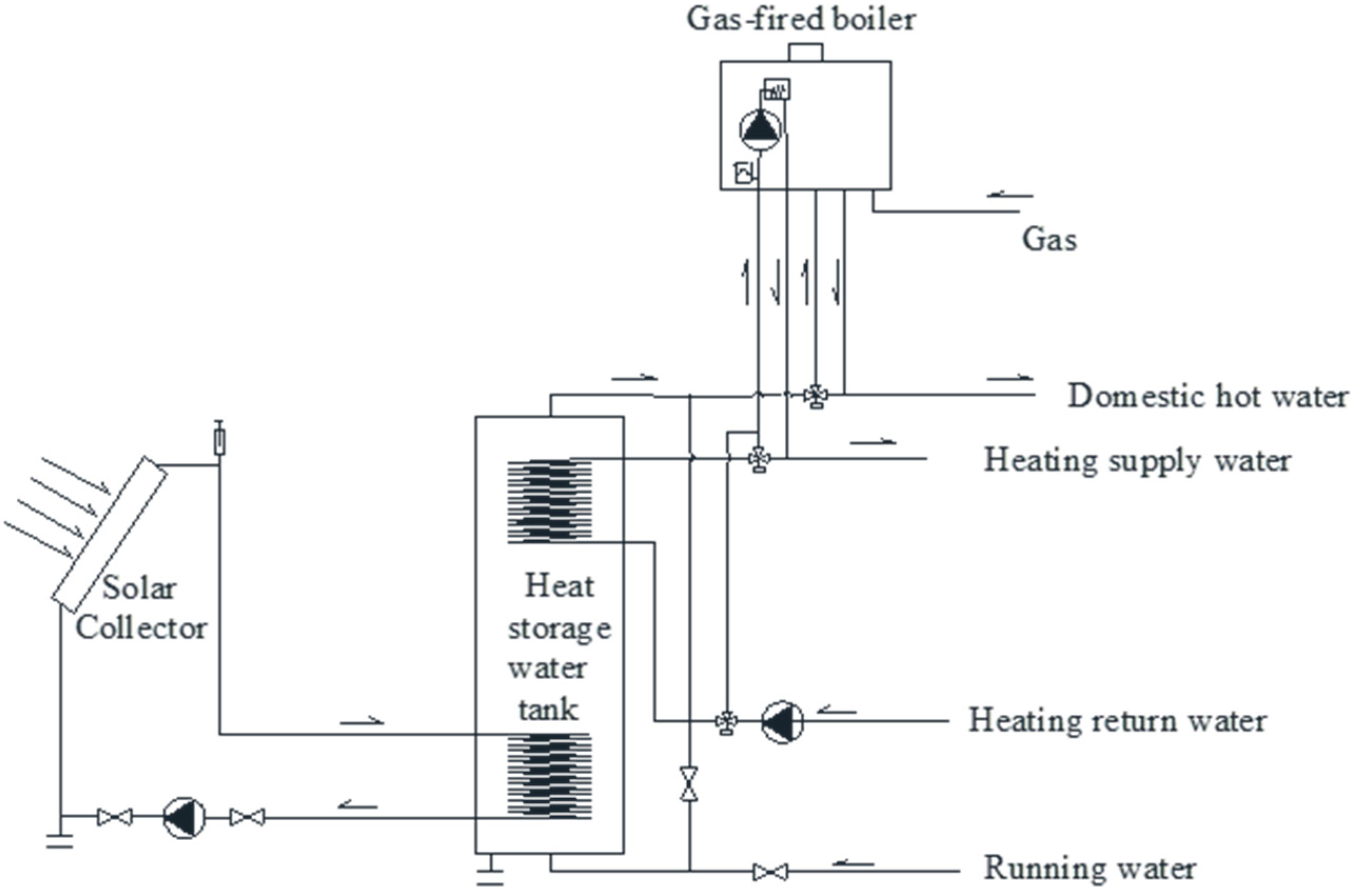
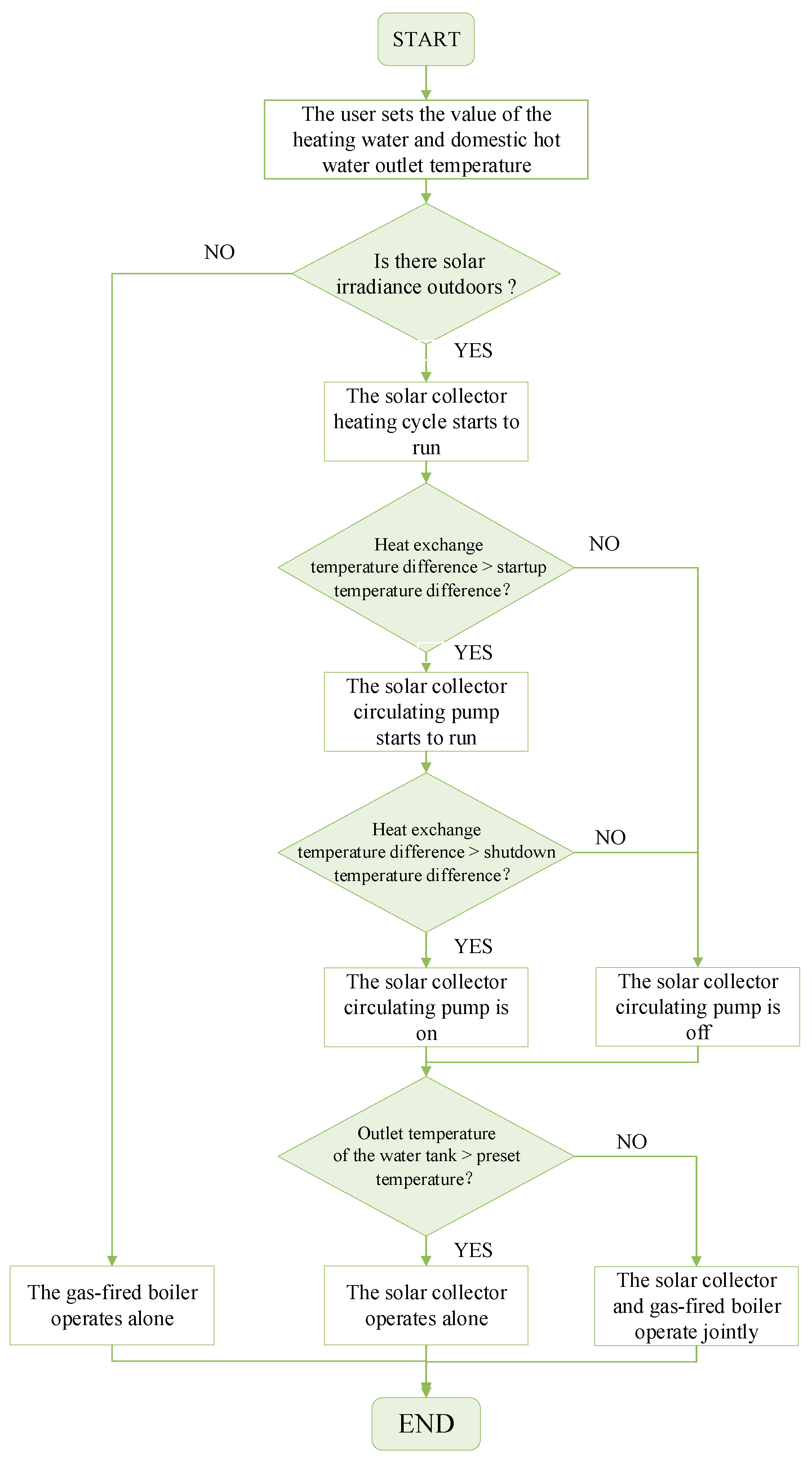


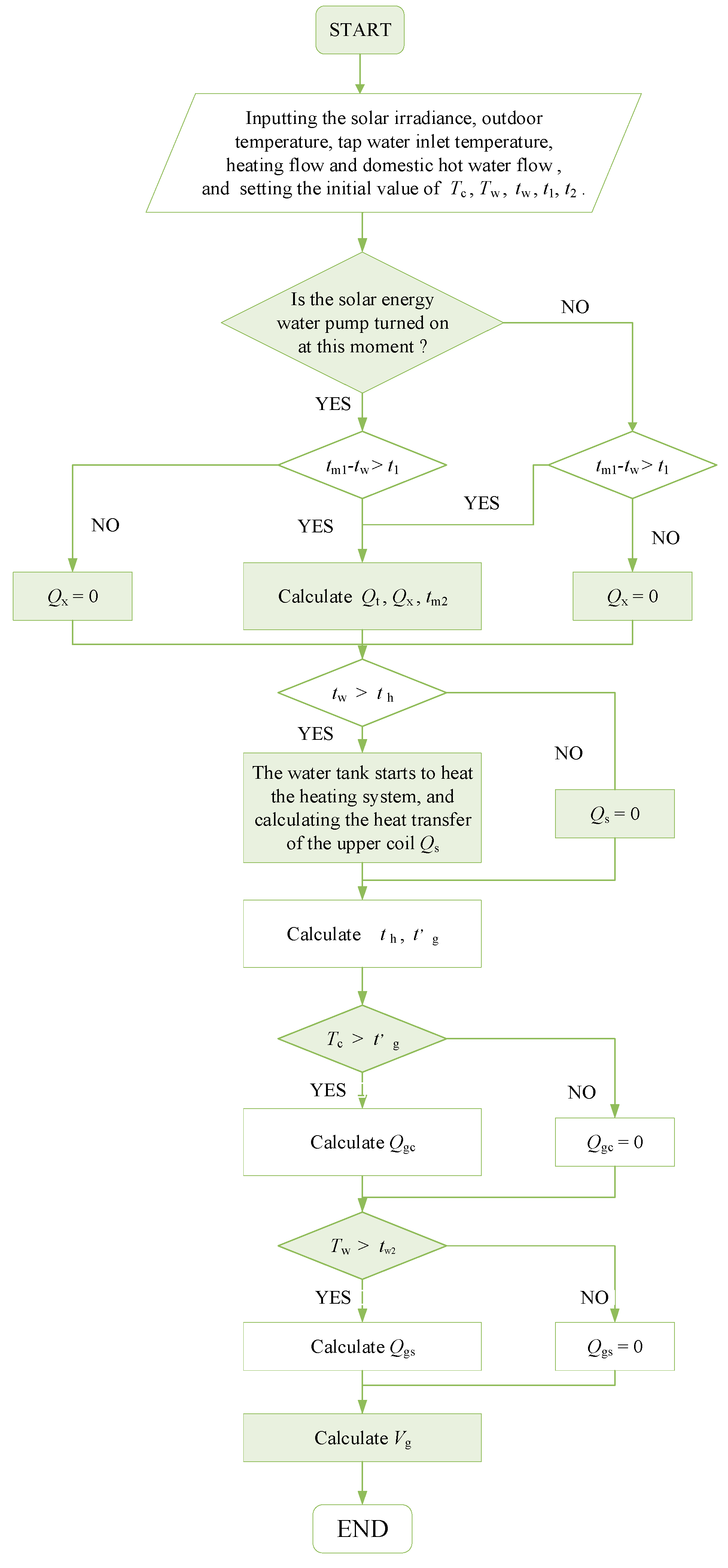

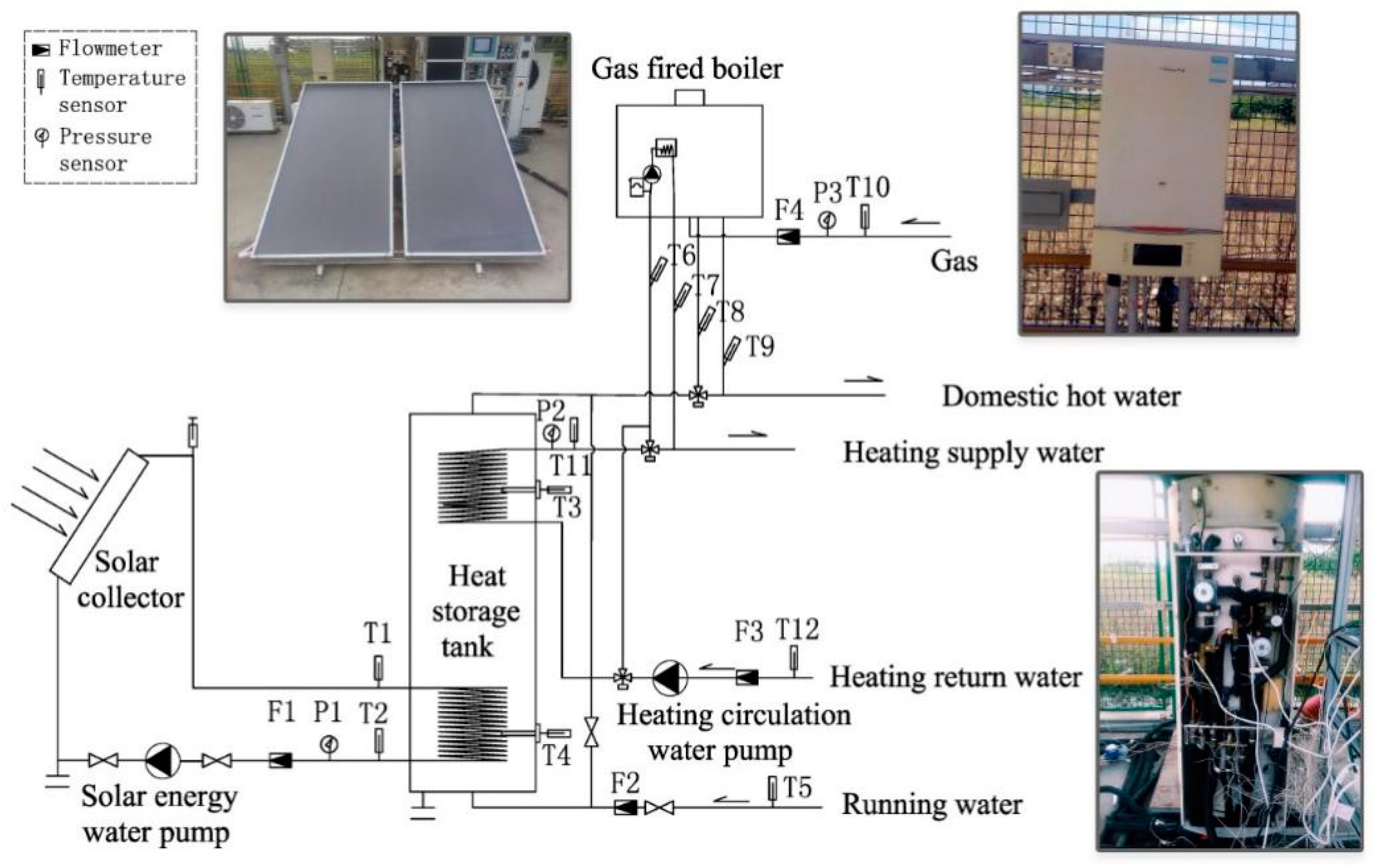





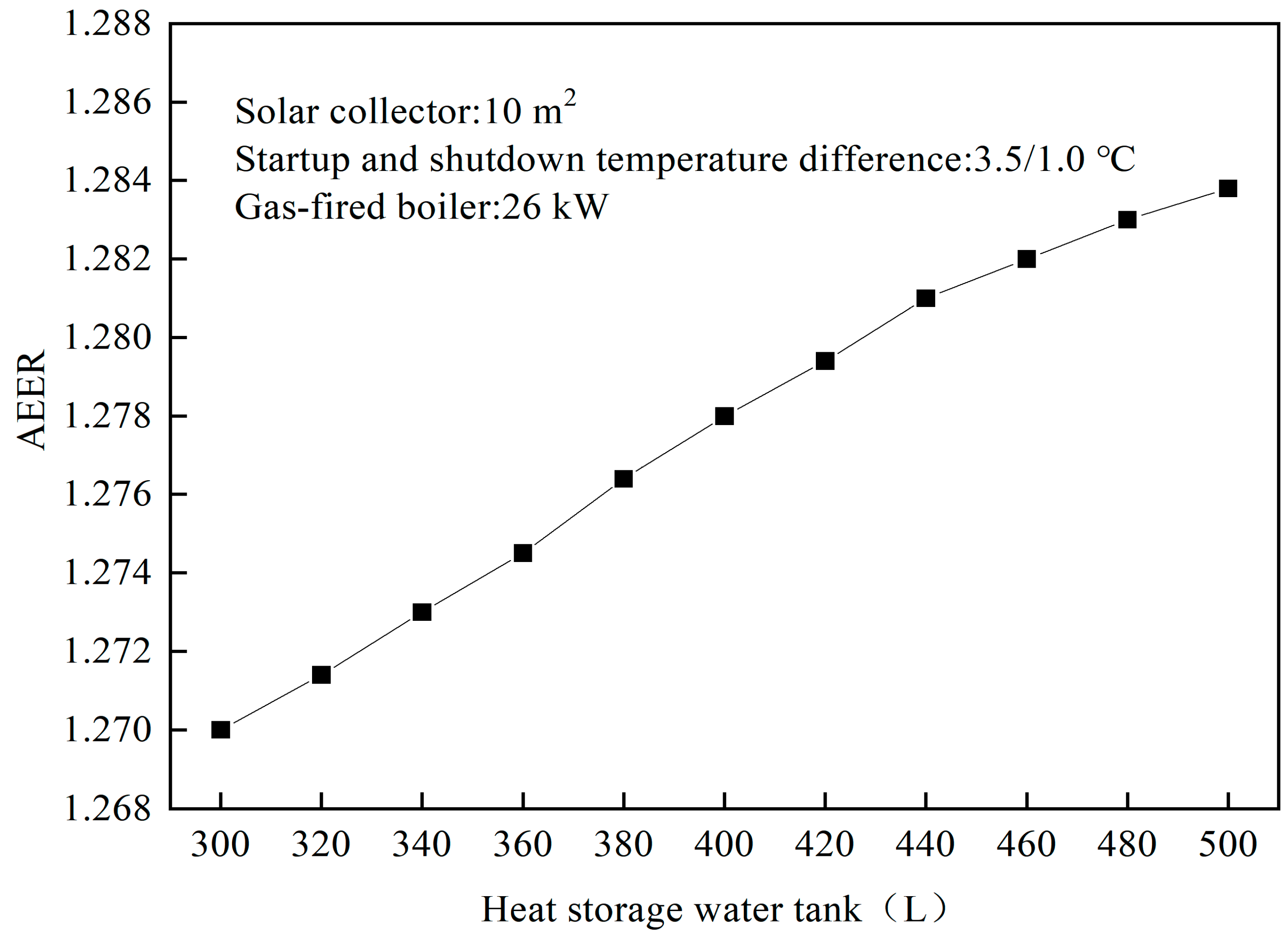
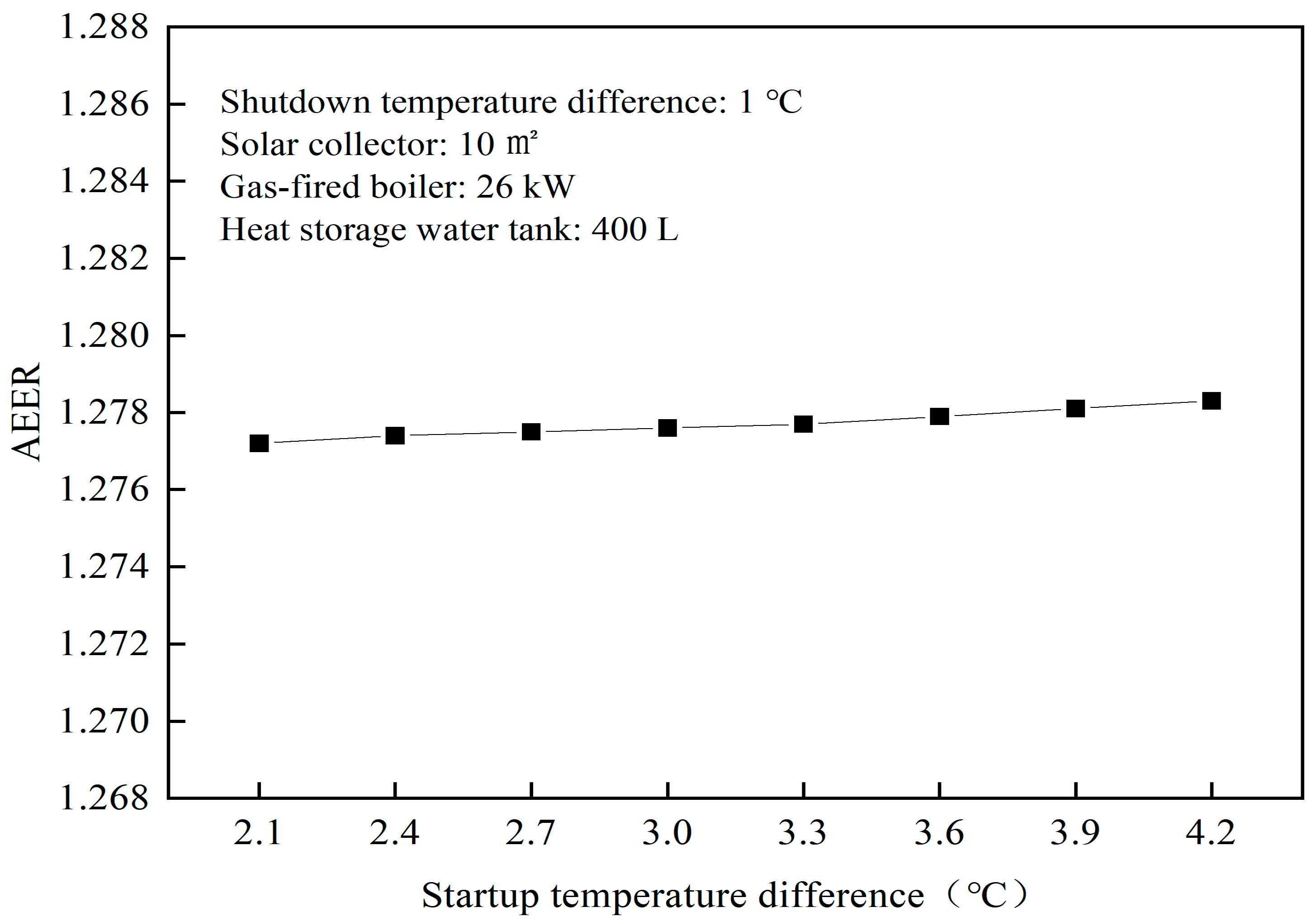



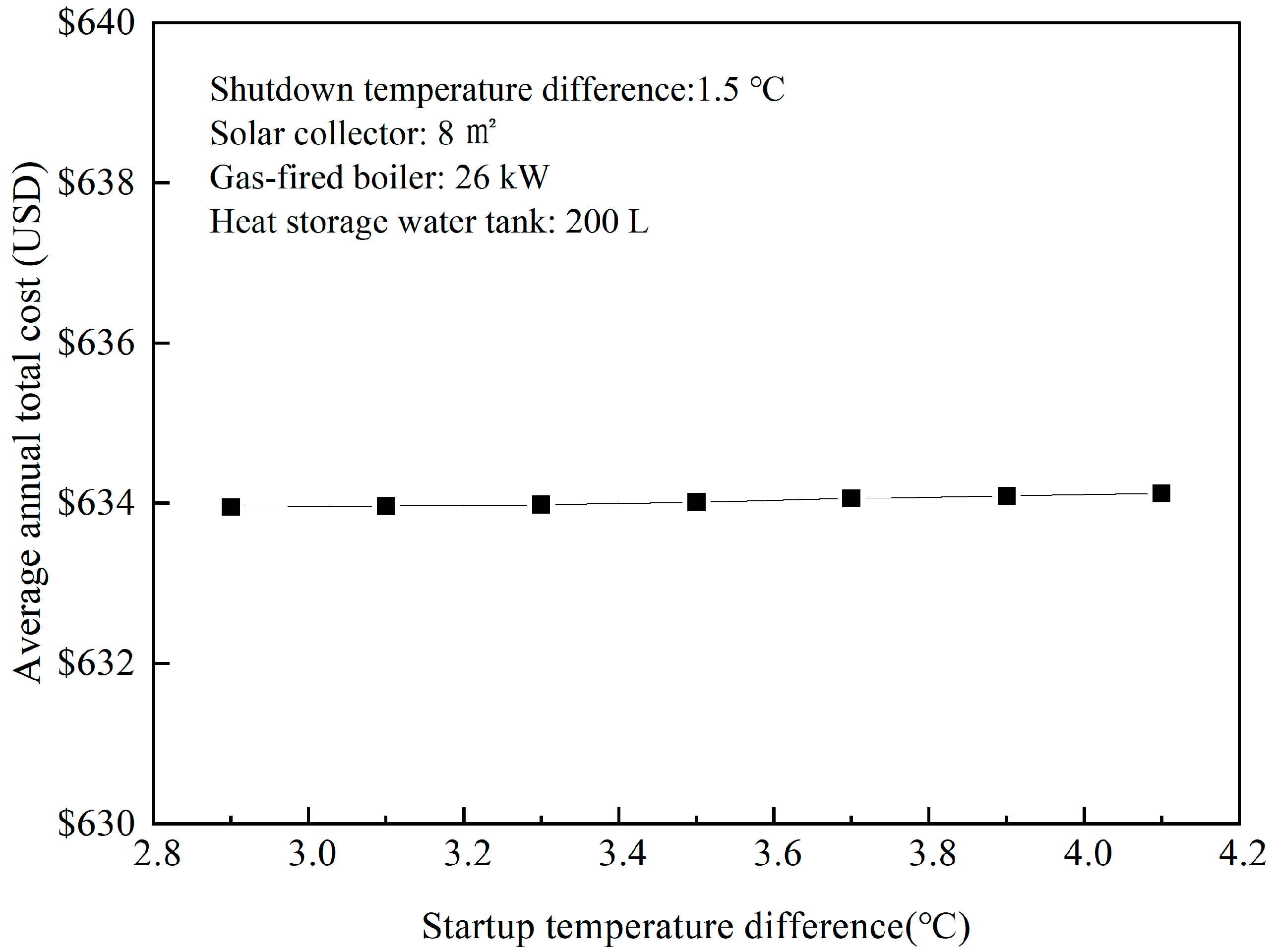
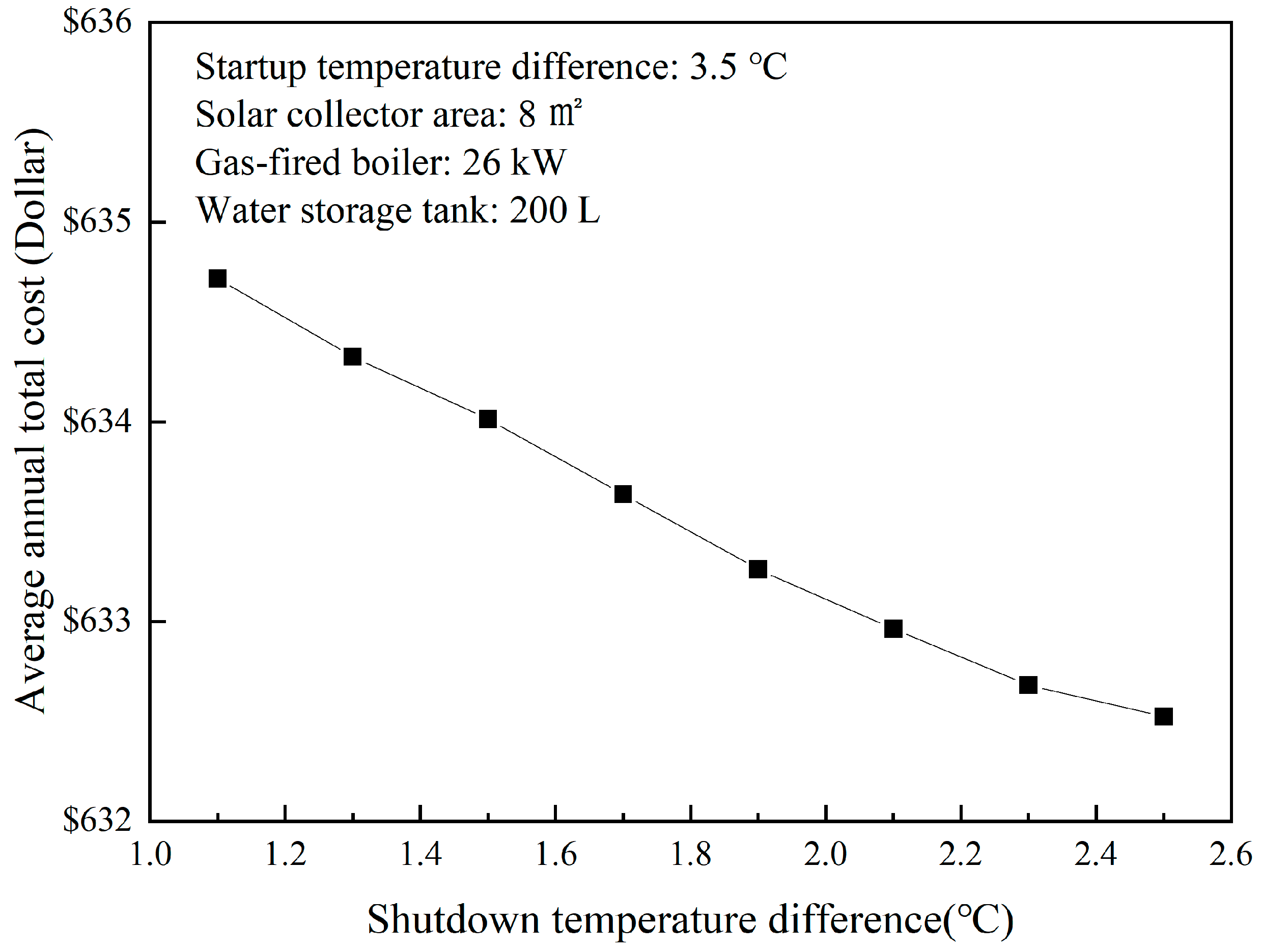
| Equipment | Technical Parameters |
|---|---|
| Solar collector | Equipment model: F-L/0.8-G/TL-1.8-ZT/K-A2 Area: 3.6 m2 Placement: oriented to the south at a tilt angle of 30° outside |
| Solar cycle working fluid | Density: 1.14 kg/L Specific heat capacity: 3.5 kJ/(kg·K) |
| Gas-fired boiler | Equipment model: L1PB20-Y36BL, Rated heating capacity: 20 KW |
| Heat storage water tank | Equipment model: SQT300 Size: 300 L Upper coils size: Φ25 × 6100 mm Lower coils size: Φ25 × 3920 mm |
| Instrument Name | Range | Precision |
|---|---|---|
| Electromagnetic flow meter | 0.14–0.6 m3/h | ±0.5% |
| Turbine flow meter | 0.14–0.36 m3/h | ±0.5% |
| Wet gas meter | 0.04–6 m3/h | ±0.5% |
| Pt100 thermometer | 0–120 °C | ±0.1 °C |
| Y-100 pressure gauge | 0–6 KPa | ±2.5% |
| Solar radiometric instrumentation | 0–2000 W/ m2 | ±15% |
| Performance Factor | Measured Value | Simulated Value | Deviation | % |
|---|---|---|---|---|
| The heat supplied by solar collectors (MJ) | 18.28 | 17.04 | 1.24 | 6.70 |
| The heat supplied by the gas-fired boiler (MJ) | 166.68 | 178.78 | 7.45 | 6.77 |
| The gas consumed by the gas-fired boiler (m3) | 5.29 | 5.60 | 0.31 | 5.53 |
| Enclosure Structure | Heat Transfer Coefficient/(W/m2·K) | Size | Quantity |
|---|---|---|---|
| Wall | 0.44 | Height 3.01 m | - |
| Windows | 2.4 | 1.8 m × 1.5 m | North: 2; East and West: 1 |
| Door | 3.02 | 1.8 m × 2.5 m | South: 1 |
| Time | Kh/% | QW/kW·h |
|---|---|---|
| 7:00 | 5 | 2344.16 |
| 8:00 | 5 | 2344.16 |
| 11:00 | 5 | 2344.16 |
| 13:00 | 5 | 2344.16 |
| 15:00 | 15 | 7032.48 |
| 16:00 | 15 | 7032.48 |
| 17:00 | 25 | 11720.80 |
| 18:00 | 25 | 11720.80 |
| Equipment | Specifications | Unit Price (USD) |
|---|---|---|
| Gas-fired boiler | 9.4–19.5 kW | 862 |
| 9.4–20.5 kW | 940 | |
| 9.4–23.5 kW | 1019 | |
| 9.4–24.5 kW | 1097 | |
| 9.4–26.5 kW | 1175 | |
| Tank | 101–200 L | 235 |
| 201–300 L | 313 | |
| 301–400 L | 392 | |
| Flat plate solar heat collector | 1 m2 | 63 |
| Combination | Solar Collector (m2) | Tank (L) | Startup Temperature Difference(°C) | Shutdown Temperature Difference (°C) |
|---|---|---|---|---|
| 1 | 4 | 200 | 3.0 | 1.0 |
| 2 | 4 | 200 | 3.0 | 2.0 |
| 3 | 4 | 300 | 3.5 | 1.0 |
| 4 | 4 | 400 | 4.0 | 1.5 |
| 5 | 6 | 200 | 3.5 | 2.0 |
| 6 | 6 | 200 | 4.0 | 1.0 |
| 7 | 6 | 300 | 3.0 | 1.5 |
| 8 | 6 | 400 | 3.0 | 1.0 |
| 9 | 8 | 200 | 3.5 | 1.5 |
| 10 | 8 | 200 | 4.0 | 1.0 |
| 11 | 8 | 300 | 3.0 | 1.0 |
| 12 | 8 | 400 | 3.0 | 2.0 |
| 13 | 10 | 200 | 4.0 | 1.5 |
| 14 | 10 | 200 | 3.0 | 1.5 |
| 15 | 10 | 300 | 4.0 | 2.0 |
| 16 | 10 | 400 | 3.5 | 1.0 |
| Combination | The Thermal Energy Provided by Solar (MJ) | The Thermal Energy Provided by Gas (MJ) | Gas Consumption (m3) | Power Consumption (kW·h) | AC (USD) | AEER |
|---|---|---|---|---|---|---|
| 1 | 6608.29 | 49,062.42 | 1290.00 | 162.70 | 651.0 | 1.160 |
| 2 | 6571.53 | 49,097.09 | 1290.92 | 132.97 | 649.0 | 1.167 |
| 3 | 6769.51 | 49,620.37 | 1304.67 | 167.71 | 664.1 | 1.161 |
| 4 | 6803.02 | 50,069.56 | 1316.48 | 150.94 | 674.5 | 1.165 |
| 5 | 8454.30 | 47,119.63 | 1238.90 | 135.29 | 641.2 | 1.212 |
| 6 | 8501.33 | 47,076.71 | 1237.79 | 162.19 | 642.9 | 1.205 |
| 7 | 8882.79 | 47,508.09 | 1249.13 | 160.40 | 647.0 | 1.213 |
| 8 | 9106.38 | 47,895.27 | 1259.32 | 177.43 | 659.4 | 1.212 |
| 9 | 9688.54 | 45,847.83 | 1205.48 | 148.67 | 634.0 | 1.240 |
| 10 | 9714.74 | 45,817.82 | 1204.69 | 162.35 | 642.0 | 1.236 |
| 11 | 10,341.14 | 46,050.66 | 1210.81 | 177.80 | 645.5 | 1.245 |
| 12 | 10,645.34 | 46,428.72 | 1220.76 | 157.45 | 654.9 | 1.256 |
| 13 | 10,557.13 | 44,947.30 | 1181.80 | 163.56 | 637.8 | 1.258 |
| 14 | 10,524.17 | 44,978.00 | 1182.61 | 149.63 | 637.1 | 1.262 |
| 15 | 10,601.27 | 45,194.89 | 1181.80 | 149.50 | 646.4 | 1.276 |
| 16 | 11,729.92 | 45,372.19 | 1192.98 | 180.50 | 657.8 | 1.278 |
Publisher’s Note: MDPI stays neutral with regard to jurisdictional claims in published maps and institutional affiliations. |
© 2021 by the authors. Licensee MDPI, Basel, Switzerland. This article is an open access article distributed under the terms and conditions of the Creative Commons Attribution (CC BY) license (https://creativecommons.org/licenses/by/4.0/).
Share and Cite
Tao, M.; Yu, Y.; Zhang, H.; Ye, T.; You, S.; Zhang, M. Research on the Optimization Design of Solar Energy-Gas-Fired Boiler Systems for Decentralized Heating. Energies 2021, 14, 3195. https://doi.org/10.3390/en14113195
Tao M, Yu Y, Zhang H, Ye T, You S, Zhang M. Research on the Optimization Design of Solar Energy-Gas-Fired Boiler Systems for Decentralized Heating. Energies. 2021; 14(11):3195. https://doi.org/10.3390/en14113195
Chicago/Turabian StyleTao, Ming, Yanzhe Yu, Huan Zhang, Tianzhen Ye, Shijun You, and Mengting Zhang. 2021. "Research on the Optimization Design of Solar Energy-Gas-Fired Boiler Systems for Decentralized Heating" Energies 14, no. 11: 3195. https://doi.org/10.3390/en14113195
APA StyleTao, M., Yu, Y., Zhang, H., Ye, T., You, S., & Zhang, M. (2021). Research on the Optimization Design of Solar Energy-Gas-Fired Boiler Systems for Decentralized Heating. Energies, 14(11), 3195. https://doi.org/10.3390/en14113195








